Payer Contracting: Three Criteria for Success
Bill Barr outlines the systematic application of three criteria to guide discounting decisions.
Deciding to contract with a payer can be among the most important decisions brand managers will make. A brand’s reimbursement position – especially one with a large PBM or health plan – can buoy its performance or it can drag a product’s financial results.
The importance of a favorable position does not mean, however, that manufacturers should agree to any concession to achieve it. Rebate decisions must be informed by an evidence-based forecast of the impact of the rebate on brand reimbursement, brand performance, and return on investment (ROI).
Rephrasing the conversation: Three criteria of a successful contract
Manufacturers often rationalize contracts by arguing that brands need “access” – a term suggesting that only two possible contracting outcomes are available – attaining access, or not.
Versus an imprudent focus on “access”, contracting decisions should be driven by the likelihood that a contract will meet these three related criteria:
Compared to not contracting…
- The relative costs the payer assigns to the contracted product will be lower.
- The fulfilled prescriptions for the contracted product will be greater.
- The net revenue generated by the product will be greater (a positive ROI).
Each of the first two criteria supports the third – a positive ROI. The following pages provide more detail on these criteria.
Criteria 1: Compared to not contracting, the relative “costs” the payer assigns to the contracted product will be lower
The raison d’etre for a contract – versus not contracting – is to lower the costs payers assign to the product. The term “costs” describes any impediment to a written and filled prescription and can be grouped into two categories:
1. Prescriber costs: Payers may assign “costs” – such as prior authorizations and step edits – that make it more difficult for a physician to prescribe.
2. Patient costs: Payers may assign costs such as high copays or coinsurance that can dampen patient use (and subsequently influence physician prescribing).
In a contract, rebate dollars must be exchanged for a reduction in at least one of these costs. Contracting evaluations must therefore begin with an examination of how a contract will affect costs assigned to a product. One useful tool for this analysis is the Cost Comparison Grid.
The Cost Comparison Grid: Comparing contracted and non-contracted costs
The Cost Comparison Grid informs a contract evaluation by comparing prescribing obstacles and patient costs between contracted and non-contracted positions. Completing this grid demands answers to three questions that clarify the differences in costs between contracted and non-contracted positions. The review concludes by summarizing the advantages between a contracted versus a non-contracted position.

The Cost Comparison Grid: From concept to application
To move from concept to a more precise application of the grid, two additional considerations must be added.
• Consider competitive agents: A contract evaluation must describe how a contract affects the costs assigned to the contracted product relative to costs assigned to competitive agents. Using hypothetical products, this grid displays this concept.
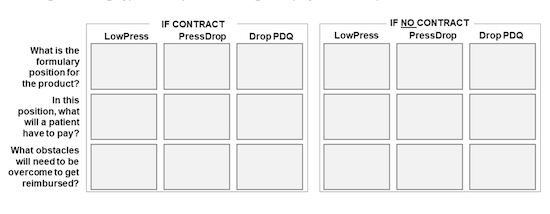
• Precisely estimate costs: Cost estimates should be made by an informed dissection of the benefit designs utilized by the payer. The following are examples of questions that should be explored to estimate costs.
Patient Out-of-Pocket Cost Analysis
Contract
No Contract
Will the patient be asked to pay a set copay or a percent coinsurance for the product?
o Copay
o Coinsurance
o Copay
o Coinsurance
Per course of treatment, what will the patient pay out of pocket for the product?
$
$
Prior Authorization (PA) Analysis
Contract
No Contract
Will there be a PA assigned to the product?
o Yes
o No
o Yes
o No
What will the requirements be to meet the PA?
Criteria 2: Versus not contracting, a contract will yield more fulfilled prescriptions
Quantifying the historical relationship between product position and product performance at an account is the best way to gauge a future contract against this criterion. The more apparent it appears that there is a relationship between position and performance across multiple products, the more probable it is that an account exerts influence on product demand and the greater the likelihood that a contract will yield more prescriptions.
Measuring influence at an account begins with gathering the following two data points for as many products as possible:
1. Relative reimbursement position of the product at the contracted account – or, what is the product’s reimbursement position relative to its competitors?
2. Relative product performance at the contracted account – or, what is the product’s market share within the plan – compared to the product’s typical market share outside of the plan?
Placing products along these metrics within a 2 x 2 grid called the Payer Influence Window™ can inform an understanding of the relationship between product position and performance at an account.
A completed Payer Influence Window can then inform the following question that is foundational to contract forecasting:
If we negotiate a relative reimbursement position of x for our product,
what relative performance can we expect to achieve for our product?
The greater the relationship between a product’s relative position and performance at an account (e.g., if they fall into either of the “Influential” quadrants below), the greater the evidence that a favorable position at an account will improve sales - or, conversely, an unfavorable position will suppress sales.
The Payer Influence Window™
A simple construct to evaluate payer influence
PAYER INFLUENCE WINDOW
Relative Performance
Below Average
Above Average
Relative Position
Good Relative Position
Influential:
Account steers demand to advantaged products (performance and position are correlated)
Poor Relative Position
Influential:
Account suppresses demand for disadvantaged products (performance and position are correlated)
Here is how the Payer Influence Window is created
Building the Payer Influence Window to forecast impact of contract on demand
ï» Building the X axis: relative performance
Place products on the X axis based on their performance within an account against their performance absent of the account’s influence. This comparison can be reflected in one ratio – the Impact Index – built using the formula below:
Impact index = product market share at account/product market share at national
The more that the impact index departs from 1 (where the product’s share at the account is equal to the product’s share nationally), the greater the likelihood is that the account is influencing share of that product. And, naturally,
• The higher the index above 1 the greater the likelihood that the account is steering prescribing towards the product.
• The lower the index below 1, the greater the likelihood that the account is steering prescribing away from the product.
ï» Building the Y axis: relative position
Placement on the Y axis should reflect a product’s reimbursement position at the contracted account relative to that of the position of competitive agents or alternatives. Placement of products along the Y axis is not as straightforward as placement on the X axis.
Although there are many challenges associated with position placement, the commitment to do so in a consistent and explainable way will help to justify and explain contracting decisions.
In our GoodCare HMO HMO example below, eight different products (labeled A to H) have been placed in their position along both the X and Y axes. Along the Y axis, the first product (A) is placed and then each subsequent product is placed based on the “cost” difference relative to those placed earlier. The products are then moved along the X axis to reflect the product’s performance.
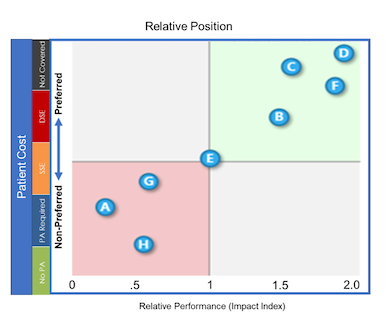
An immediate yield from the Payer Influence Window is an appreciation of the influence the account has on product demand. GoodCare, for example, is high control – it clearly drives performance of advantaged products.
Applying the Payer Influence Window to inform contracting decisions
The Payer Influence Window is useful in informing an estimate of the value of a reimbursement position – a key input into a contracting decision. Conceptually, the value of a position is the difference in gross revenue generated between two positions – e.g., a favorable contracted position versus an unfavorable non-contracted position, as shown graphically below.
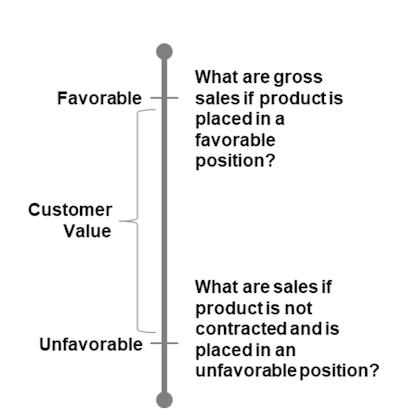
Formulaically, the value of a position is expressed below.[1]

Completing the above formula is a foundational step in a contracting decision. Here is background on how to complete each variable.
Variable A: Brand’s forecasted gross revenue during contracting term
Tying contracting analytics into a brand forecast ensures that results can be translated into overall brand impact. Seek to link all contract analytics to a brand’s revenue forecast.
Variable B: Percent contribution the account should make to brand forecast
Contracting teams should know the percentage of overall brand sales contributed by each account (and thus the potential affected by a contract). For example, the following sentence should be completed for each key account.
• If Product X were to perform at par with the national rate within Aetna, Aetna would pay for or process ___% of Product X’s national prescriptions.
A figure expressed as a percentage contribution ensures that results reflects a brand’s forecasted growth throughout a contracted period (e.g., 5% of a forecast will change as the forecast changes).
Variable C: Applying the contracted vs. no contract impact index
This is an estimate of the impact index (discussed earlier) that the product will achieve in both an on-contract (favorable) position and an off-contract (unfavorable) position.[2]
To estimate this variable, the following questions need to be answered:
• If Product X contracts and is placed in a favorable position, what impact index will the product achieve at the account?
• If Product X does not contract and is placed in an unfavorable position, what impact index will the product achieve at the account?
The Payer Influence Window – informed by historical brand performance and position data – is useful in informing these estimates in the following way.
ï» Using the Payer Influence Window to Estimate Impact Indices
Consider product costs for on-contract and off-contract positions gathered under Criteria 1, earlier. Identify the products with relative reimbursement positions most like the positions available to the brand at the account. The relative performance of these products can be suitable proxies for the performance of the contracted agent – when placed in similar positions.
For example, let’s assume that Product B on the graphic below has a reimbursement position most like that of the position achieved if Product X succeeds in contracting. Conversely, product H is in a position most like the non-contracted position.
Placement of each product on the Payer Influence Window connects position with performance. For example, on our hypothetical window:
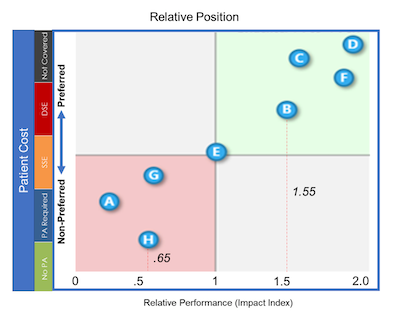
• In its reimbursement position, Product B performs at an index of 1.55 (i.e., 55% above its national share).
• Product H performs at an index of .65 (i.e., 35% below its national share).
Precision is not a realistic goal of analog selection. Instead, the goal is to gather evidence to inform a forecast of product performance when placed in a specific reimbursement position. And the best source of this evidence is the historical relationship between position and performance at the contracted account, as expressed using the Payer Influence Window.
Case Study: Pulling it all together to estimate contract value
LowPress brand managers are considering contracting with GoodCare for a two-year term. The analytics team gathered the following details on the contract:
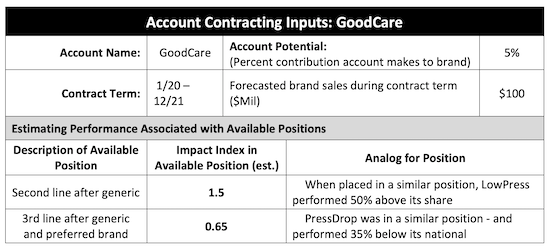
These figures can be placed into our formula from above to estimate a gross value of a contract.

Criteria 3: Will the contract yield a positive return on investment (ROI)?
Results from the two prior criteria explorations can inform a contract ROI measurement – the concluding criteria of contract evaluation. ROI measures efficiency of each dollar invested by dividing the incremental benefit (or net return) of an investment by the cost of the investment.
The classic ROI equation below can be expressed to measure Net ROI of a contract below.

This equation can be translated into an ROI equation for a contract:

Continuing the case study:
By including a rebate percentage (35%), we can continue our case study started above to estimate ROI.
Discount = 35%
With this information, we can complete an ROI.

ï» Moving from a static ROI to analysis over time
In the previous example, ROI was measured at a static point in time. A more accurate ROI needs to consider a time dimension as well. A time dimension is necessary because it takes time for an account to move demand towards preferred agents.
Will a contract with your account meet the three criteria of a successful contract?
Indicate your level of agreement with the following statements:
Criteria
Strongly Disagree
Disagree
Neither Agree nor Disagree
Agree
Strongly Agree
1. Compared with not contracting, contracting will reduce costs to patients and/or physicians.
ï±
ï±
ï±
ï±
ï±
2. A contract will generate/ enable more Rxs from the account
ï±
ï±
ï±
ï±
ï±
3. A contract will yield a positive ROI.
ï±
ï±
ï±
ï±
ï±
Bill Barr is a partner at Acuitas Analytics.
Notes
[1] Whereas value of a contract can be expressed in prescriptions, patients, or units, it is most useful for contracting when value is expressed in dollar sales.
[2] Note that there may be more than two possible positions in which a product may be placed. An impact index needs to be built for each possible position. For simplicity and for this example, we assume that only two positions are available.
The Misinformation Maze: Navigating Public Health in the Digital Age
March 11th 2025Jennifer Butler, chief commercial officer of Pleio, discusses misinformation's threat to public health, where patients are turning for trustworthy health information, the industry's pivot to peer-to-patient strategies to educate patients, and more.
Navigating Distrust: Pharma in the Age of Social Media
February 18th 2025Ian Baer, Founder and CEO of Sooth, discusses how the growing distrust in social media will impact industry marketing strategies and the relationships between pharmaceutical companies and the patients they aim to serve. He also explains dark social, how to combat misinformation, closing the trust gap, and more.
Applying Porter’s Five Forces to Portfolio Management in Pharmaceutical R&D: A Strategic Roadmap
March 17th 2025The increasing costs and complexity of R&D in the pharmaceutical industry have necessitated the adoption of strategic portfolio management to optimize resource allocation and enhance competitive advantage.